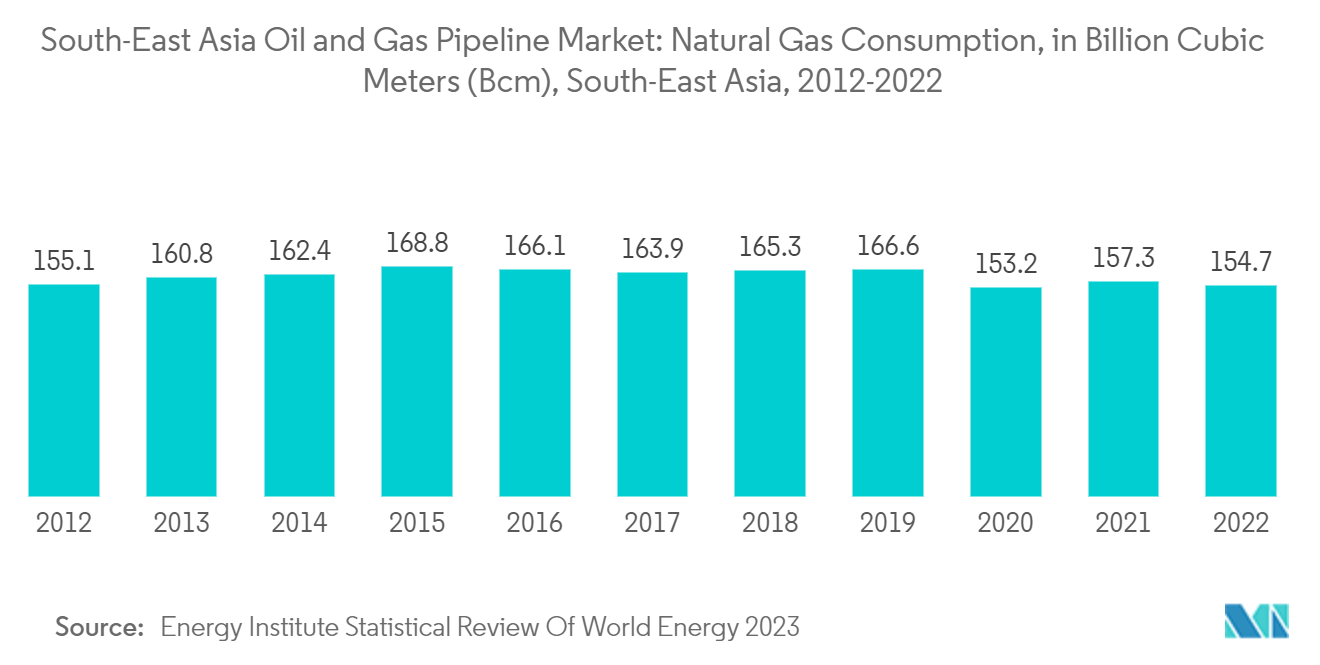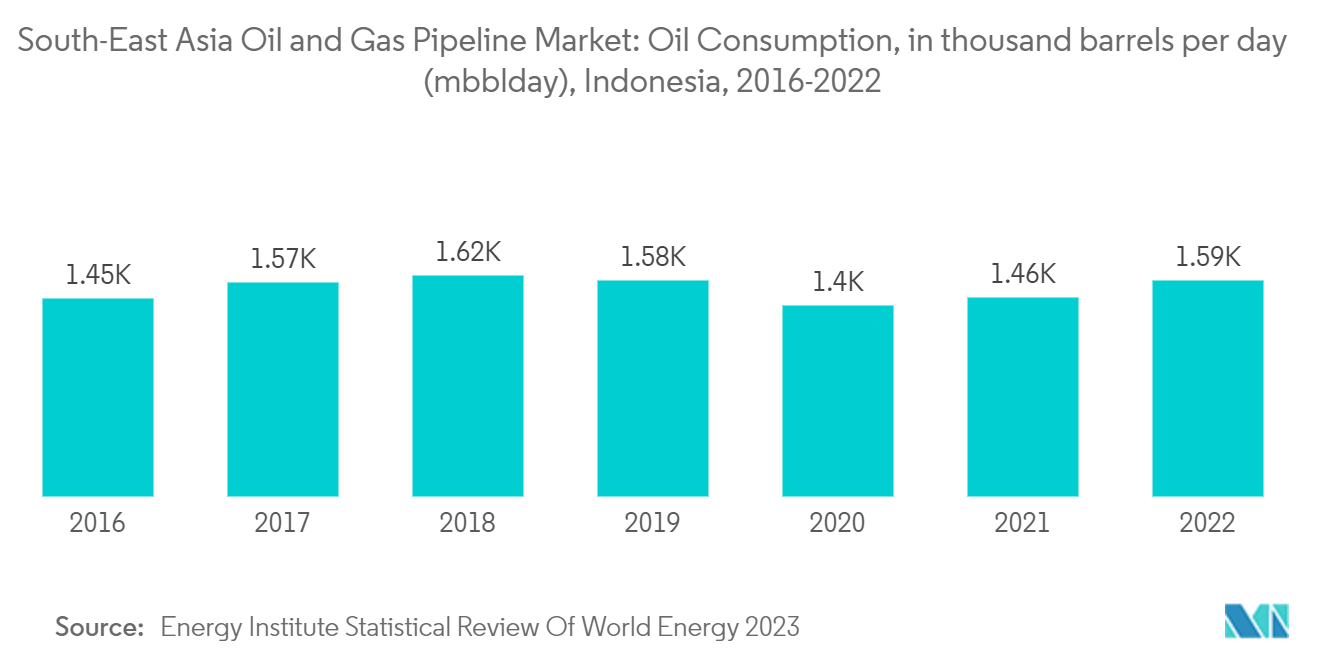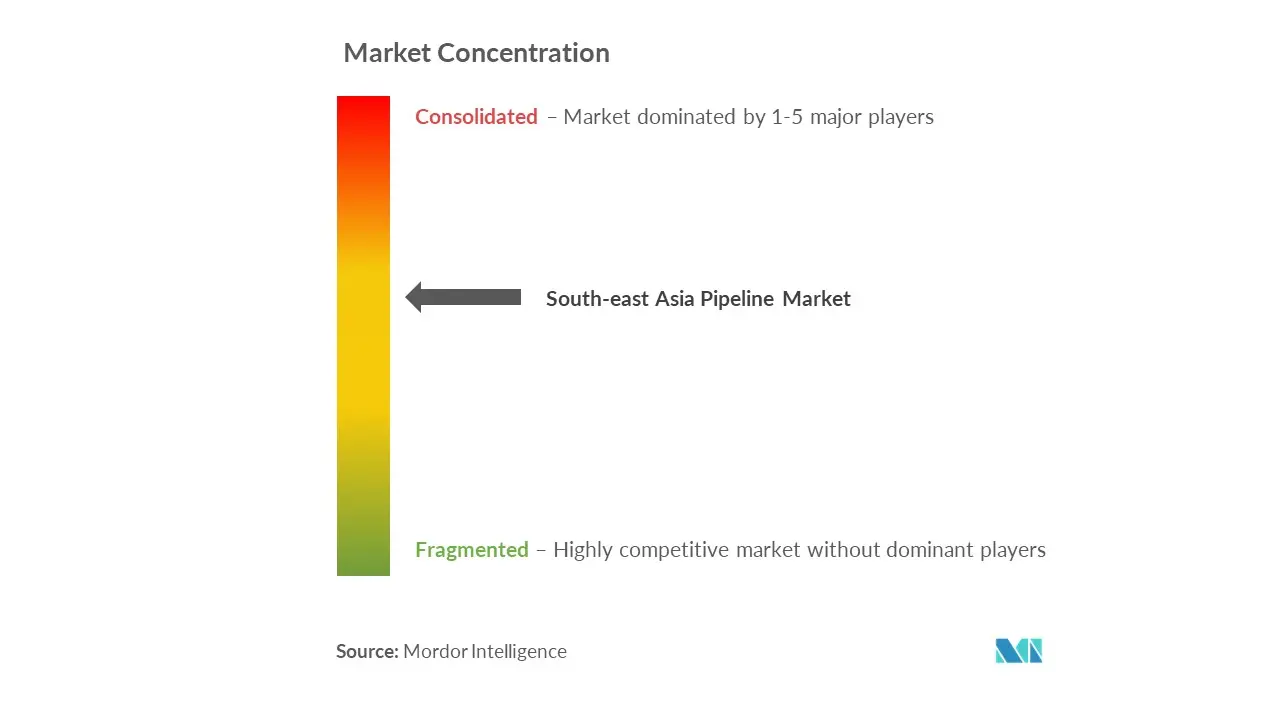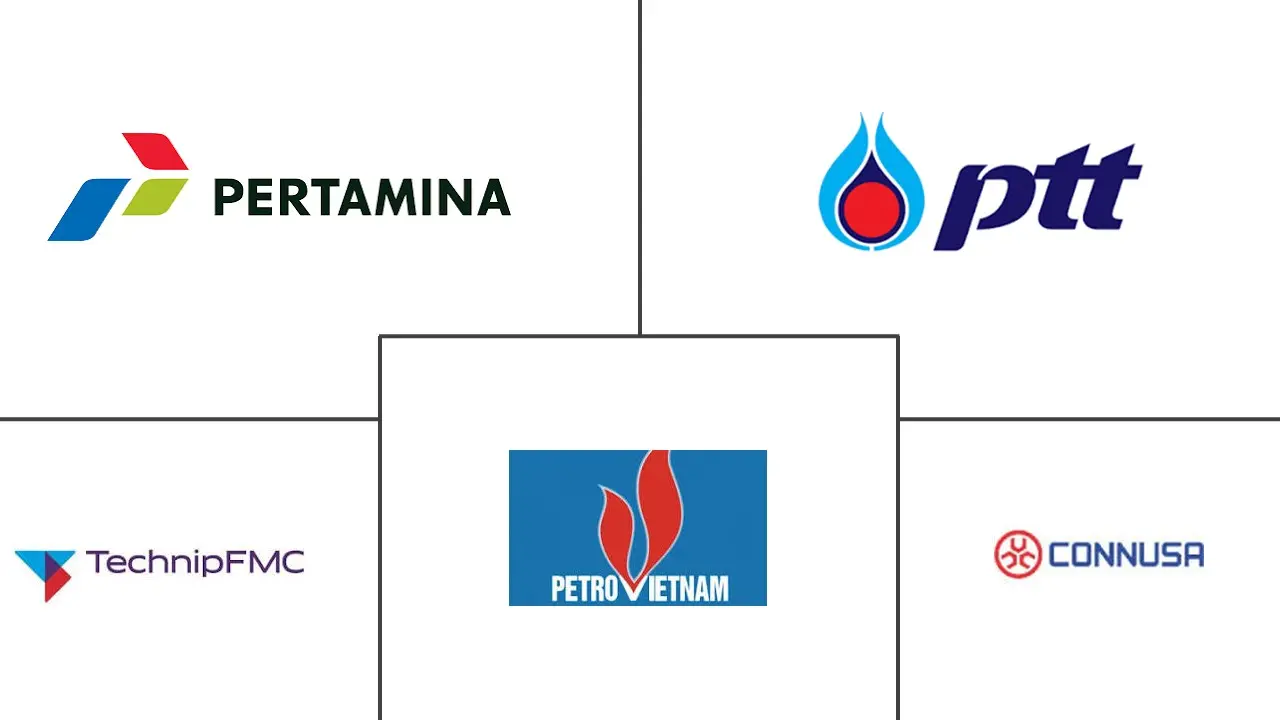South-East Asia Oil And Gas Pipeline Market Size and Share

South-East Asia Oil And Gas Pipeline Market Analysis by Mordor Intelligence
The South-East Asia Oil And Gas Pipeline Market size is estimated at USD 1.52 billion in 2025, and is expected to reach USD 1.81 billion by 2030, at a CAGR of greater than 3.55% during the forecast period (2025-2030).
- In the medium term, the increasing energy demand in the region and emerging export opportunities in the area are expected to drive the Southeast Asian oil and gas pipeline market.
- However, the volatility in energy prices is expected to hinder the growth of the market studied in Southeast Asia.
- The increasing deployment of smart pipeline systems, such as monitoring systems, is expected to provide growth opportunities in the forecast period.
- Indonesia is expected to dominate the Southeast Asian oil and gas pipeline market due to the country being the largest energy consumer and the increasing demand for oil and gas in the region during the forecast period.
South-East Asia Oil And Gas Pipeline Market Trends and Insights
Gas Pipeline Segment to Dominate the Market
- With the region's burgeoning population and economic expansion, the need for cleaner and more efficient energy sources has intensified. Natural gas, as a relatively cleaner-burning fossil fuel, aligns with environmental concerns and economic growth aspirations. This shift in energy preference toward natural gas drives the development and expansion of gas pipeline infrastructure.
- According to the Energy Institute Statistical Review of World Energy, in 2022, natural gas consumption reached an all-time low in the past decade due to the industrial slowdown in the region. However, consumption is expected to increase in the coming years as most countries in the area focus on reducing fossil fuel consumption and rising natural gas consumption.
- Furthermore, Southeast Asia's geographical characteristics favor the dominance of gas pipelines. The region comprises numerous archipelagos and islands, and maritime transport of oil can be logistically challenging and costly. In contrast, gas pipelines provide a cost-effective and efficient solution for transporting natural gas across these difficult terrains. This geographic advantage contributes to the inclination toward gas pipelines as the preferred mode of energy transportation.
- Southeast Asia is witnessing increased investments in gas infrastructure, including the development of liquefied natural gas (LNG) terminals and associated pipelines. These investments facilitate the import and distribution of LNG, offering a cleaner energy alternative. As natural gas gains prominence as a primary energy source, channels play a pivotal role in transporting LNG from terminals to consumption centers, thereby bolstering the significance of the gas pipeline segment.
- For instance, in September 2023, Malaysia's Bumi Armada made an agreement with a subsidiary of the Indonesian energy company Pertamina and natural gas trading firm PT Davenergy Mulia Perkasa. The agreement pertains to the development and commercialization of liquefied natural gas (LNG). As part of this arrangement, the companies would establish fundamental principles for the development and commercialization of LNG extracted from the Madura Gas Field and the adjacent fields in Indonesia.
- Therefore, according to the points discussed above, the gas pipeline segment is expected to dominate the market studied during the forecast period.

Indonesia expected to be the Largest Geographic Segment
- Indonesia has abundant natural resources, notably its extensive reserves of oil and natural gas. The country is a significant oil and gas producer, and the need to efficiently transport these resources to refineries, distribution points, and export terminals is paramount. The vast reserves and the continuous exploration for new sources create a compelling case for the expansion of oil and gas pipeline infrastructure in Indonesia.
- According to the Energy Institute Statistical Review of World Energy, oil consumption in the country increased by 8.5% between 2021 and 2022. In 2022, oil consumption was 1,585 thousand barrels per day compared to 1,461 thousand barrels per day in 2021.
- Indonesia's strategic geographic location plays a crucial role in its expected dominance in the oil and gas pipeline market. The nation consists of numerous islands and archipelagos, necessitating the construction of pipelines for efficient energy transportation. Gas pipelines, in particular, offer a cost-effective and reliable means of transporting natural gas across challenging terrain, connecting production sites to urban centers and industrial zones.
- In January 2023, Casakha announced that the commencement of design, engineering, and project management activities would take place promptly at its Jakarta offices. The offshore installation is scheduled for 2023, as outlined by the Indonesian subsea and offshore consultancy. The defined scope of work encompasses detailed engineering design, installation, transportation, and engineering tasks related to a 16-inch (40.6 centimeters) offshore pipeline connecting the LPRO and EPRO platforms.
- The growing demand for energy in Indonesia is a driving force behind the expansion of the oil and gas pipeline sector. The country's expanding population, coupled with economic development, fuels the need for energy resources. To meet this demand, investments in pipeline projects are imperative, and these pipelines serve as the primary mode of transporting oil and gas to meet the energy requirements of households, businesses, and industries.
- Indonesia's regulatory framework and government support are instrumental in its dominance in the oil and gas pipeline market. The government actively promotes the development of energy infrastructure and encourages investment in pipeline projects. Favorable regulations and incentives provided by regulatory bodies create an environment conducive to the growth of the pipeline sector, both for domestic use and export.
- Therefore, according to the points discussed above, Indonesia is expected to dominate the market studied during the forecast period.

Competitive Landscape
The Southeast Asian oil and gas pipeline market is moderately fragmented. Some of the major players in the market (in no particular order) include PT Pertamina, PTT Public Company Limited, TechnipFMC PLC, PetroVietnam, and PT. Connusa Energindo, among others.
South-East Asia Oil And Gas Pipeline Industry Leaders
-
PTT Public Company Limited
-
PT Pertamina
-
TechnipFMC plc
-
Vietnam Oil and Gas Group
-
PT. Connusa Energindo
- *Disclaimer: Major Players sorted in no particular order

Recent Industry Developments
- July 2023: McDermott International Ltd secured a construction contract related to a Shell PLC pipeline project situated on Borneo Island in Malaysia. This offshore pipeline is designated to serve the F22, F27, and Selasih fields located in Sarawak state. As part of the contract, McDermott would be responsible for the transportation and installation services pertaining to two pipeline segments and one section of flexible pipelay.
- June 2023: Bangkok Aviation Fuel Services PLC (BAFS) planned to construct a fresh oil pipeline to interconnect its networks, with the goal of enhancing its trade activities in the northern region. This 52-kilometer pipeline is expected to span from Saraburi to Ang Thong, enabling the efficient transport of oil from the Eastern region to the Northern region. BAFS was engaged in discussions with Thai Petroleum Pipeline Co. regarding this prospective oil pipeline initiative.
South-East Asia Oil And Gas Pipeline Market Report Scope
Oil and gas pipelines are a system of interconnected pipes and infrastructure used to transport crude oil, natural gas, and related products over long distances, typically from production sites to refineries, distribution points, or end-users. These pipelines are a critical component of the energy infrastructure, allowing for the efficient and reliable movement of hydrocarbons.
The Southeast Asian oil and gas pipeline market is segmented by location of deployment, type, and geography. By location of deployment, the market studied is segmented into onshore and offshore. By type, the market studied is segmented into crude oil and natural gas. The report also covers the market size and forecasts for the oil and gas pipeline market across the major countries. The report offers the market size in value terms in USD for all the abovementioned segments.
Key Questions Answered in the Report
How big is the South-East Asia Oil And Gas Pipeline Market?
The South-East Asia Oil And Gas Pipeline Market size is expected to reach USD 1.52 billion in 2025 and grow at a CAGR of greater than 3.55% to reach USD 1.81 billion by 2030.
What is the current South-East Asia Oil And Gas Pipeline Market size?
In 2025, the South-East Asia Oil And Gas Pipeline Market size is expected to reach USD 1.52 billion.
Who are the key players in South-East Asia Oil And Gas Pipeline Market?
PTT Public Company Limited, PT Pertamina, TechnipFMC plc, Vietnam Oil and Gas Group and PT. Connusa Energindo are the major companies operating in the South-East Asia Oil And Gas Pipeline Market.
What years does this South-East Asia Oil And Gas Pipeline Market cover, and what was the market size in 2024?
In 2024, the South-East Asia Oil And Gas Pipeline Market size was estimated at USD 1.47 billion. The report covers the South-East Asia Oil And Gas Pipeline Market historical market size for years: 2020, 2021, 2022, 2023 and 2024. The report also forecasts the South-East Asia Oil And Gas Pipeline Market size for years: 2025, 2026, 2027, 2028, 2029 and 2030.
Page last updated on:
South-East Asia Oil And Gas Pipeline Market Report
Statistics for the 2025 South-East Asia Oil And Gas Pipeline market share, size and revenue growth rate, created by Mordor Intelligence™ Industry Reports. South-East Asia Oil And Gas Pipeline analysis includes a market forecast outlook for 2025 to 2030 and historical overview. Get a sample of this industry analysis as a free report PDF download.



